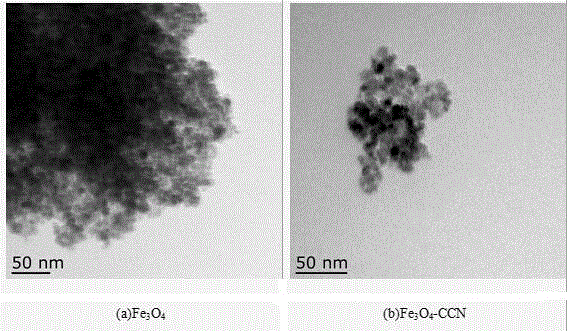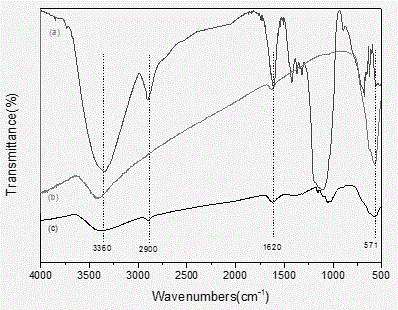Method for adsorbing lead ions in solution by nanocrystalline cellulose magnetic particles
A technology of nanocrystalline cellulose and magnetic particles, applied in chemical instruments and methods, adsorption water/sewage treatment, alkali metal oxides/hydroxides, etc., can solve the problem of low adsorption capacity, affecting adsorption selectivity and adsorption capacity, etc. problem, to achieve the effect of large adsorption capacity, low cost and good effect
- Summary
- Abstract
- Description
- Claims
- Application Information
AI Technical Summary
Problems solved by technology
Method used
Image
Examples
Embodiment 1
[0026] A method for nanocrystalline cellulose magnetic particles to absorb lead ions in a solution, the method is to prepare nanocrystalline cellulose from microcrystalline cellulose, then prepare nanocrystalline cellulose magnetic particles through graft modification, and finally convert nanocrystalline cellulose to Magnetic particles are encapsulated in microcapsules to obtain a nanocrystalline cellulose magnetic particle adsorbent, and the adsorbent is used to adsorb lead ions in the solution.
[0027] The preparation method of nanocrystalline cellulose is to add microcrystalline cellulose and strongly acidic cation exchange resin to 1000mL deionized water at a mass ratio of 1:15, stir at 65°C, and ultrasonically treat for 1h at an ultrasonic frequency of 60KHz to catalyze hydrolysis. After the completion, the cation exchange resin was filtered out, and the cellulose sample was separated, and the cellulose sample was centrifuged at 15,000 r / min for 5 minutes, and the nanocry...
Embodiment 2
[0032] A method for nanocrystalline cellulose magnetic particles to absorb lead ions in a solution, the method is to prepare nanocrystalline cellulose from microcrystalline cellulose, then prepare nanocrystalline cellulose magnetic particles through graft modification, and finally convert nanocrystalline cellulose to Magnetic particles are encapsulated in microcapsules to obtain a nanocrystalline cellulose magnetic particle adsorbent, and the adsorbent is used to adsorb lead ions in the solution.
[0033] The preparation method of nanocrystalline cellulose is to add microcrystalline cellulose and strongly acidic cation exchange resin into 1000mL deionized water at a mass ratio of 1:18, stir at 68°C, and ultrasonically treat for 2 hours at an ultrasonic frequency of 70KHz to catalyze hydrolysis. After the completion, the cation exchange resin was filtered out, and the cellulose sample was separated, and the cellulose sample was centrifuged at 18,000 r / min for 7 minutes to obtain...
Embodiment 3
[0038] A method for nanocrystalline cellulose magnetic particles to absorb lead ions in a solution, the method is to prepare nanocrystalline cellulose from microcrystalline cellulose, then prepare nanocrystalline cellulose magnetic particles through graft modification, and finally convert nanocrystalline cellulose to Magnetic particles are encapsulated in microcapsules to obtain a nanocrystalline cellulose magnetic particle adsorbent, and the adsorbent is used to adsorb lead ions in the solution.
[0039] The preparation method of nanocrystalline cellulose is to add microcrystalline cellulose and strongly acidic cation exchange resin into 1000mL deionized water at a mass ratio of 1:20, stir at 70°C, and ultrasonically treat for 2.5h at an ultrasonic frequency of 80KHz to catalyze After the hydrolysis, the cation exchange resin was filtered out, and the cellulose sample was separated, and the cellulose sample was centrifuged at 20000r / min for 10min to obtain nanocrystalline cell...
PUM
 Login to View More
Login to View More Abstract
Description
Claims
Application Information
 Login to View More
Login to View More - R&D
- Intellectual Property
- Life Sciences
- Materials
- Tech Scout
- Unparalleled Data Quality
- Higher Quality Content
- 60% Fewer Hallucinations
Browse by: Latest US Patents, China's latest patents, Technical Efficacy Thesaurus, Application Domain, Technology Topic, Popular Technical Reports.
© 2025 PatSnap. All rights reserved.Legal|Privacy policy|Modern Slavery Act Transparency Statement|Sitemap|About US| Contact US: help@patsnap.com



